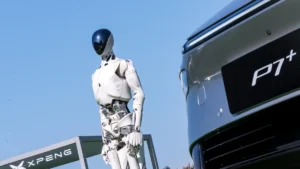
Robots Could Taste Food Like Humans with an ‘Electronic Tongue’
Super-thin sensors are like first step for machines to copy how we taste things.

Scientists at Penn State are working on making robots able to taste things, like how they can already see, hear, and touch stuff. They’re making something called an ‘electronic tongue’ that’s super tiny and can sniff out tiny bits of gas and chemicals.
Right now, robots can’t really crave snacks, but this might help them in the future to suggest what food is good, make restaurant menus, & even teach people to like new foods.
But there’s a catch. Humans don’t just eat for nutrition; we also eat because we like the taste. Our taste buds tell our brains what tastes good and bad, which can be helpful to avoid eating bad stuff, but also makes us eat extra treats sometimes. This whole taste thing is pretty complex, and robots don’t quite understand it like we do.
“Understanding human behavior is easy to see but hard to measure, which makes it tough to teach a robot to be emotionally smart. Right now, there’s no clear way to do it,” said Saptarshi Das, an engineering professor at Penn State.
Das and his team recently designed a robot that can “taste” molecules using a special device they created called an “electronic gustatory complex.” They used super-thin sensors called chemitransistors, made from graphene, to detect tiny gas and chemical particles.
They combined these with memtransistors made from molybdenum disulfide, which can simulate neurons. These two parts worked together, using their different strengths to simulate the ability to “taste” things at the molecular level.
“Graphene is really good at sensing chemicals, but it’s not great for making circuits that work like the brain,” explained Andrew Pannone, a graduate student on the team. “So, we used molybdenum disulfide. By combining these materials, we made a circuit that acts like the sense of taste in the brain.”
Never miss any important news. Subscribe to our newsletter.
Related News


British Investor Who Predicted US Slump Warns of Next Crash

I’m a Death Doula: 4 Reasons I Believe Death Isn’t the End


Tech to Reverse Climate Change & Revive Extinct Species

AI Unlocks the Brain’s Intelligence Pathways

XPENG Unveils Iron Robot with 60 Human-like Joints

Can AI Outsmart Humanity?

11 ChatGPT Prompts to Boost Your Personal Brand

Keir Starmer Hints at Possible Tax Hikes on Asset Income

Navigating the Future of AI: Insights from Eric Schmidt
